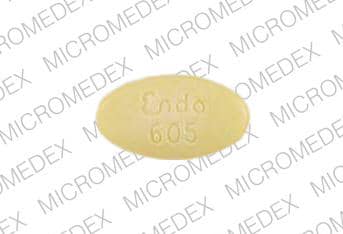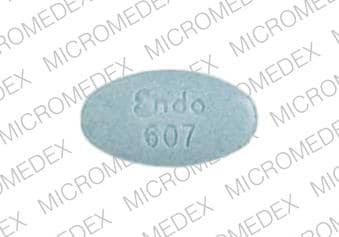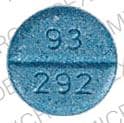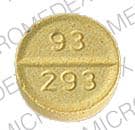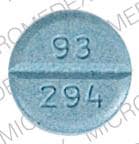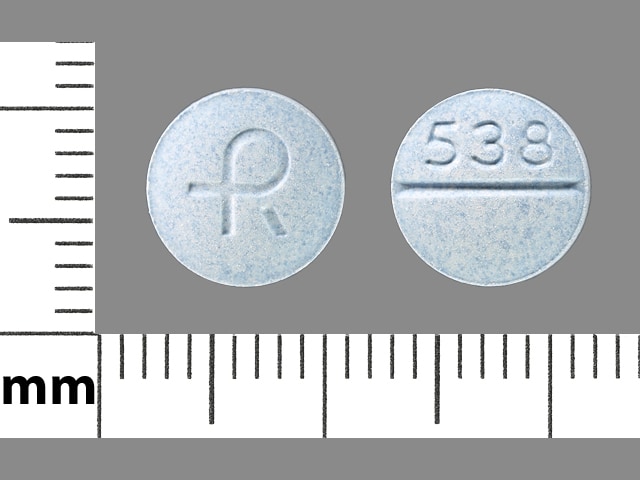Dosage Forms
Excipient information presented when available (limited, particularly for generics); consult specific product labeling.
Capsule Extended Release, Oral:
Rytary: Carbidopa 23.75 mg and levodopa 95 mg, Carbidopa 36.25 mg and levodopa 145 mg, Carbidopa 48.75 mg and levodopa 195 mg, Carbidopa 61.25 mg and levodopa 245 mg [contains fd&c blue #2 (indigotine)]
Suspension, Enteral:
Duopa: Carbidopa 4.63 mg and levodopa 20 mg per mL (100 mL)
Tablet, Oral:
Sinemet: Carbidopa 10 mg and levodopa 100 mg, Carbidopa 25 mg and levodopa 250 mg [contains fd&c blue #2 aluminum lake]
Sinemet: Carbidopa 25 mg and levodopa 100 mg [contains fd&c yellow #10 aluminum lake]
Generic: Carbidopa 10 mg and levodopa 100 mg, Carbidopa 25 mg and levodopa 100 mg, Carbidopa 25 mg and levodopa 250 mg
Tablet Disintegrating, Oral:
Generic: Carbidopa 10 mg and levodopa 100 mg, Carbidopa 25 mg and levodopa 100 mg, Carbidopa 25 mg and levodopa 250 mg
Tablet Extended Release, Oral:
Sinemet CR: Carbidopa 25 mg and levodopa 100 mg, Carbidopa 50 mg and levodopa 200 mg [contains fd&c blue #2 aluminum lake, fd&c red #40 aluminum lake]
Generic: Carbidopa 25 mg and levodopa 100 mg, Carbidopa 50 mg and levodopa 200 mg
Pharmacology
Mechanism of Action
Parkinson disease symptoms are due to a lack of striatal dopamine; levodopa circulates in the plasma to the blood-brain-barrier (BBB), where it crosses, to be converted by striatal enzymes to dopamine; carbidopa inhibits the peripheral plasma breakdown of levodopa by inhibiting its decarboxylation, and thereby increases available levodopa at the BBB
Pharmacokinetics/Pharmacodynamics
Absorption
Absorption of levodopa may be decreased with high-fat, high-calorie or high-protein meal.
Distribution
Levodopa: 0.9 to 1.6 L/kg (in presence of carbidopa), crosses the blood-brain barrier; Carbidopa: Does not cross the blood-brain barrier
Metabolism
Levodopa has two major pathways (decarboxylation and O-methylation) and two minor pathways (transamination and oxidation) of metabolism; Carbidopa inhibits the decarboxylation of levodopa to dopamine in the peripheral tissue to allow greater levodopa distribution into the CNS
Excretion
Urine
Time to Peak
Immediate release: 0.5 hours; Controlled and extended release: 2 hours; Intestinal gel [Canadian product]: Therapeutic plasma levels reached 10 to 30 minutes following morning bolus dose; Intestinal suspension: 2.5 hours
Half-Life Elimination
Immediate release: Levodopa (in presence of carbidopa): 1.5 hours; Half-life may be prolonged with controlled and extended release formulations due to continuous absorption.
Use in Specific Populations
Special Populations: Elderly
The AUC and Cmax of levodopa may be increased in elderly patients.
Special Populations: Gender
Increased carbidopa and levodopa peak concentrations and systemic exposure in females compared with males.
Use: Labeled Indications
Parkinson disease: Treatment of Parkinson disease, postencephalitic parkinsonism, and symptomatic parkinsonism that may follow carbon monoxide and/or manganese intoxication; treatment of motor fluctuations in advanced Parkinson disease (intestinal suspension [Duopa] only).
Use: Off Label
Restless leg syndrome, intermittentyes
Based on the American Academy of Sleep Medicine (AASM) practice parameters for the treatment of restless legs syndrome and periodic limb movement, the use of carbidopa and levodopa is an effective and recommended alternative treatment option in patients with intermittent restless leg syndrome (RLS) that does not require daily therapy; however, a risk of RLS symptom augmentation and early morning rebound symptoms exists with this therapy (AASM [Aurora 2012]).
The European Federation of Neurological Societies/European Neurological Society/European Sleep Research Society (EFNS/ENS/ESRS) Task Force guidelines for the management of restless leg syndrome consider levodopa effective in reducing RLS symptoms as an on-demand treatment in intermittent RLS (EFNS/ENS/ESRS [Garcia-Borreguero 2012]).
Based on the International Restless Legs Syndrome Study Group, European Restless Legs Syndrome Study Group, and RLS Foundation (IRLSSG/EURLSSG/RLS-F) guidelines for the prevention and treatment of dopaminergic augmentation in restless legs syndrome, levodopa may be effective for intermittent RLS limiting the frequency to only 2 to 3 administrations per week due to the risk of augmentation (IRLSSG/EURLSSG/RLS-F [Garcia-Borreguero 2016]).
Clinical experience also suggests the utility of carbidopa and levodopa in the management of RLS Silber 2004.
Contraindications
Hypersensitivity to levodopa, carbidopa, or any component of the formulation; concurrent use with nonselective monoamine oxidase inhibitors (MAOIs) or use within the last 14 days
Tablets: Additional contraindications: Narrow angle glaucoma
Canadian labeling: Additional contraindications (not in US labeling): Clinical or laboratory evidence of uncompensated cardiovascular, endocrine, hepatic, hematologic or pulmonary disease (eg, including bronchial asthma), or renal disease; when administration of a sympathomimetic amine (eg, epinephrine, norepinephrine, isoproterenol) is contraindicated; in the presence of a suspicious, undiagnosed skin lesion or history of melanoma; intestinal gel therapy in patients with any condition preventing the required placement of a PEG tube for administration (ie, pathological changes of gastric wall, inability to bring gastric and abdominal wall together, blood coagulation disorders, peritonitis, acute pancreatitis, paralytic ileus).
Dosage and Administration
Dosing: Adult
Parkinson disease:
Oral:
Immediate-release tablet, orally disintegrating tablet: Note: Carbidopa/levodopa tablets are available in a 1:4 ratio of carbidopa to levodopa as well as 1:10 ratio. Tablets of the two ratios may be given separately or combined as needed to provide the optimum dosage.
Initial: Carbidopa 25 mg/levodopa 100 mg 3 times daily (preferred) or carbidopa 10 mg/levodopa 100 mg 3 to 4 times daily (typically does not provide an adequate amount of carbidopa for most patients)
Patients previously treated with levodopa <1,500 mg daily: Carbidopa 25 mg/levodopa 100 mg 3 or 4 times daily
Patients previously treated with levodopa >1,500 mg daily: Carbidopa 25 mg/levodopa 250 mg 3 or 4 times daily
Note: Discontinue levodopa at least 12 hours before starting therapy with carbidopa/levodopa. Substitute the combination drug at a dosage that will provide approximately 25% of the previous levodopa dosage.
Dosage adjustment: Alternate tablet strengths may be substituted according to individual carbidopa/levodopa requirements. Use of more than 1 dosage strength or dosing 4 times daily may be required (maximum: 8 tablets of any strength daily or 200 mg of carbidopa and 2,000 mg of levodopa).
Carbidopa 10 mg/levodopa 100 mg: Increase by 1 tablet daily or every other day, as necessary, to 2 tablets 4 times daily.
Carbidopa 25 mg/levodopa 100 mg: Increase by 1 tablet daily or every other day.
Carbidopa 25 mg/levodopa 250 mg: Increase by 1/2 or 1 tablet daily or every other day.
Controlled-release tablet:
Patients not currently receiving levodopa: Initial: Carbidopa 50 mg/levodopa 200 mg 2 times daily, at intervals not <6 hours
Patients currently receiving levodopa: Note: Discontinue levodopa at least 12 hours before starting carbidopa/levodopa therapy. Initial: Substitute at a dosage that will provide approximately 25% of the previous levodopa dosage; usual initial dose in mild to moderate disease is carbidopa 50 mg/levodopa 200 mg 2 times daily
Patients converting from immediate-release formulation to controlled release: Initial: Dosage should be substituted at an amount that provides ~10% more of levodopa/day; total calculated dosage is administered in divided doses 2 to 3 times/day (or ≥3 times/day for patients maintained on levodopa ≥700 mg). Intervals between doses should be 4 to 8 hours while awake; when divided doses are not equal, smaller doses should be given toward the end of the day. Depending on clinical response, dosage may need to be increased to provide up to 30% more levodopa/day.
Dosage adjustment: May adjust every 3 days; intervals should be >4 hours during the waking day (maximum dose: 8 tablets/day)
Extended-release capsule: Note: Carbidopa/levodopa extended-release (ER) capsules are not interchangeable with other carbidopa/levodopa products on a 1:1 basis.
Patients not currently receiving levodopa: Initial: Carbidopa 23.75 mg/levodopa 95 mg 3 times daily for 3 days; on day 4, increase to carbidopa 36.25 mg/levodopa 145 mg 3 times daily. May increase dose up to carbidopa 97.5 mg/levodopa 390 mg 3 times a day; frequency of dosing may be increased to a maximum of 5 times daily if needed and tolerated (maximum: carbidopa 612.5 mg/levodopa 2,450 mg per day).
Patients converting from immediate-release formulation to ER capsules: Note: For patients currently treated with immediate-release carbidopa/levodopa plus catechol-O-methyl transferase (COMT) inhibitors (eg, entacapone) and converting to ER capsules, the initial total daily dose of carbidopa/levodopa ER capsules may need to be increased. Use of carbidopa/levodopa ER capsules in combination with other levodopa products has not been studied.
Initial: Initial dose based off of total current daily dose of levodopa in immediate-release carbidopa/levodopa as follows:
If total daily dose of levodopa is between 400 mg to 549 mg: 3 capsules of carbidopa 23.75 mg/levodopa 95 mg 3 times daily (levodopa total daily dose: 855 mg).
If total daily dose of levodopa is between 550 mg to 749 mg: 4 capsules of carbidopa 23.75 mg/levodopa 95 mg 3 times daily (levodopa total daily dose: 1,140 mg).
If total daily dose of levodopa is between 750 mg to 949 mg: 3 capsules of carbidopa 36.25 mg/levodopa 145 mg 3 times daily (levodopa total daily dose: 1,305 mg).
If total daily dose of levodopa is between 950 mg to 1249 mg: 3 capsules of carbidopa 48.75 mg/levodopa 195 mg 3 times daily (levodopa total daily dose: 1,755 mg).
If total daily dose of levodopa is ≥1,250 mg: 4 capsules of carbidopa 48.75 mg/levodopa 195 mg 3 times daily (levodopa total daily dose: 2,340 mg) or 3 capsules of carbidopa 61.25/levodopa 245 mg 3 times daily (levodopa total daily dose: 2,205 mg).
Dosage adjustment: Adjust dose as needed; frequency of dosing may be increased to a maximum of 5 times daily if needed and tolerated (maximum dose: carbidopa 612.5 mg/levodopa 2,450 mg per day). Adjust dose and frequency in response to any motor complications that arise (Espay 2017).
Intestinal infusion via PEG-J tube:
Intestinal suspension (Duopa): Initial: Note: Prior to initiation of therapy, convert patients from all forms of levodopa to oral immediate-release carbidopa/levodopa tablets (1:4 ratio). Total daily dose (expressed in terms of levodopa) consists of a morning dose, a continuous dose and extra doses. Maximum dose is 2,000 mg of the levodopa component (ie, one cassette per day) over 16 hours. Patients should receive their routine night-time dosage of oral immediate-release carbidopa/levodopa after discontinuation of daily infusion.
Morning dose and continuous dose: Refer to manufacturer’s labeling for morning dose and continuous dose calculations and titration instructions.
Extra doses: Can be used to manage acute "off" symptoms that are not controlled by the morning and continuous dose. Set extra dose function at 1 mL (20 mg of levodopa) initially; adjust in 0.2 mL increments if needed. Maximum: One extra dose every 2 hours. Note: Frequent extra doses may cause or worsen dyskinesias.
Discontinuation: Avoid sudden discontinuation or rapid dose reduction; taper dose or switch patients to oral immediate-release carbidopa-levodopa.
Intestinal gel (Duodopa [Canadian product]): Note: Conversion to/from oral levodopa tablet formulations and the intestinal gel formulation can be done on a 1:1 ratio. Total daily dose (expressed in terms of levodopa) consists of a morning bolus dose, a continuous maintenance dose, and additional bolus doses when necessary. Nighttime dosing may be necessary in certain rare situations (eg, nocturnal akinesia). Dosage adjustments should be carried out over a period of a few weeks. Patients should receive their routine night-time dosage of oral levodopa/carbidopa after discontinuation of daily infusion
Morning bolus dose:
Day 1: Based on a percentage of the previous morning levodopa intake and volume to fill intestinal tubing:
Previous morning dose of levodopa ≤200 mg: Administer Duodopa at 80% of dose
Previous morning dose of levodopa 201 to 399 mg: Administer Duodopa at 70% of dose
Previous morning dose of levodopa ≥400 mg: Administer Duodopa at 60% of dose
Day 2 and beyond till dose is stable: Adjust dose based on response to the previous morning levodopa intake and volume to fill intestinal tubing): Usual: Levodopa 100 to 200 mg (5 to 10 mL); Maximum: Levodopa 300 mg (15 mL)
Continuous maintenance dose: Adjustable in increments of 2 mg/hour (0.1 mL/hour) and based on previous daily intake of levodopa: Usual: Levodopa 40 to 120 mg/hour (2 to 6 mL/hour) infused up to 16 hours; Range: Levodopa 20 to 200 mg/hour (1 to 10 mL/hour). Higher doses may be necessary in exceptional cases.
Additional bolus doses: Usual: Levodopa: 10 to 40 mg (0.5 to 2 mL), if needed for rapid deterioration of motor functions (eg, hypokinesia); may give additional doses hourly until stable dose is established then give every 2 hours as needed. In patients requiring >5 additional boluses/day, consider increasing the maintenance dose
Restless legs syndrome, intermittent (off-label use) (Silber 2004): Oral:
Immediate-release tablet: Carbidopa 25 mg/levodopa 100 mg (0.5 to 1 tablet) given in the evening, at bedtime, or upon waking during the night as needed for restless legs syndrome (RLS) symptoms.
Controlled-release tablet: Carbidopa 25 mg/levodopa 100 mg (1 tablet) before bedtime as needed for RLS symptoms that awaken patient during the night.
Note: Due to risk of augmentation, some guidelines recommend limiting the frequency to 2 to 3 administrations per week (IRLSSG/EURLSSG/RLS-F [Garcia-Borreguero 2016]).
Dosing: Geriatric
Refer to adult dosing.
Dosing: Adjustment for Toxicity
Intestinal suspension (Duopa):
Dyskinesias or levodopa-related adverse reactions within 1 hour of morning dose on preceding day: Decrease morning dose by 1 mL.
Dyskinesias or adverse reactions lasting ≥1 hour on the preceding day: Decrease the continuous dose by 0.3 mL per hour.
Dyskinesias or adverse reactions lasting for 2 or more periods of ≥1 hour on the preceding day: Decrease the continuous dose by 0.6 mL per hour.
Reconstitution
Intestinal suspension (Duopa): Fully thaw in refrigerator prior to use. To ensure controlled thawing, take the cartons containing the seven individual cassettes out of the transport box and separate the cartons from each other. Assign a 12-week, use-by date based on the time the cartons are put into the refrigerator to thaw (may take up to 96 hours to thaw). Once thawed, the individual cartons may be packed in a closer configuration within the refrigerator. Remove one cassette from refrigerator 20 minutes prior to administration (failure to use at room temperature may result in inaccurate dosage).
Extemporaneously Prepared
An oral suspension containing carbidopa 1.25 mg and levodopa 5 mg per mL may be made with tablets. Crush ten tablets each containing carbidopa 25 mg and levodopa 100 mg and reduce to a fine powder. Add small portions of a 1:1 mixture of Ora-Sweet® and Ora-Plus® and mix to a uniform paste; mix while adding the vehicle in equal proportions to almost 200 mL; transfer to a calibrated bottle, rinse mortar with vehicle, and add sufficient quantity of vehicle to make 200 mL. Label "shake well" and "refrigerate". Stable 42 days under refrigeration. Also stable 28 days at room temperature.
Nahata MC, Morosco RS, and Leguire LE, "Development of Two Stable Oral Suspensions of Levodopa-Carbidopa for Children With Amblyopia," J Pediatr Ophthalmol Strabismus, 2000, 37(6):333-7.11392406
Administration
Intestinal suspension (Duopa): Remove one cassette from refrigerator 20 minutes prior to use (failure to use at room temperature may result in inaccurate dosage). Administer as a 16-hour infusion through either a nasojejunal tube (temporary administration) or through a percutaneous endoscopic gastrostomy-jejunostomy (PEG-J) tube (long-term administration) connected to the CADD-Legacy 1400 pump. At the end of administration, disconnect the tube from the pump at the end of the infusion and flush with room-temperature drinking water with a syringe. Following discontinuation of the daily infusion, patients should administer their routine night-time dosage of oral immediate-release carbidopa/levodopa.
Intestinal gel (Duodopa [Canadian product]): Gel is administered directly to the jejunum via a portable infusion pump (CADD-legacy Duodopa pump). Administer through a temporary nasojejunal tube for a short-term test period to evaluate patient response and for dose optimization. Long-term administration requires placement of PEG-J tube for intestinal infusion. Continuous maintenance dose is infused throughout the day for up to 16 hours if necessary, may administer at night (eg, nocturnal akinesia). Disconnect PEG-J tube from infusion pump at end of infusion and flush with room temperature water to prevent occlusion of tubing. Following discontinuation of the daily infusion, patients should administer their routine night-time dosage of oral levodopa/carbidopa.
Extended-release capsule: Administer with or without food; a high-fat, high-calorie meal may delay the absorption of levodopa by ~2 hours. Swallow capsules whole; do not chew, divide, or crush capsules. Patients who have difficulty swallowing intact capsules may open the capsule, sprinkle entire contents on a small amount of applesauce (1 to 2 tablespoons) and consume immediately (do not store for future use).
Oral tablet formulations: Space doses evenly over the waking hours. Administer with meals to decrease GI upset. Controlled release product should not be chewed or crushed. Orally disintegrating tablets do not require water; the tablet should disintegrate on the tongue's surface before swallowing.
Dietary Considerations
Avoid high protein diets (>2 g/kg) which may decrease the efficacy of levodopa via competition with amino acids in crossing the blood-brain barrier. Some products may contain phenylalanine.
Storage
Oral formulations: Store at 25°C (77°F); excursions permitted between 15°C to 30°C (59°F to 86°F). Protect from light and moisture.
Intestinal suspension (Duopa): Store in freezer at -20°C (-4°F). Fully thaw in refrigerator at 2°C to 8°C (36°F to 46°F) prior to use; protect from light. To ensure controlled thawing, remove the cartons containing the seven individual cassettes from the transport box and separate the cartons from each other. Assign a 12-week, use-by date based on the time the cartons are put in the refrigerator to thaw (may take up to 96 hours to thaw). Once thawed, the individual cartons may be packed in a closer configuration within the refrigerator. Cassettes are for single use only and should be discarded daily following infusion (up to 16 hours). Do not re-use opened cassettes.
Intestinal gel (Duodopa [Canadian product]): Store in refrigerator at 2°C to 8°C (36°F to 46°F). Keep in outer carton to protect from light. Cassettes are for single use only and should be discarded daily following infusion (up to 16 hours).
Carbidopa and Levodopa Images
Drug Interactions
Alfuzosin: May enhance the hypotensive effect of Blood Pressure Lowering Agents. Monitor therapy
Alizapride: May diminish the therapeutic effect of Anti-Parkinson Agents (Dopamine Agonist). Avoid combination
Amifostine: Blood Pressure Lowering Agents may enhance the hypotensive effect of Amifostine. Management: When amifostine is used at chemotherapy doses, blood pressure lowering medications should be withheld for 24 hours prior to amifostine administration. If blood pressure lowering therapy cannot be withheld, amifostine should not be administered. Consider therapy modification
Amisulpride: May diminish the therapeutic effect of Anti-Parkinson Agents (Dopamine Agonist). Anti-Parkinson Agents (Dopamine Agonist) may diminish the therapeutic effect of Amisulpride. Avoid combination
Antipsychotic Agents (First Generation [Typical]): May diminish the therapeutic effect of Anti-Parkinson Agents (Dopamine Agonist). Anti-Parkinson Agents (Dopamine Agonist) may diminish the therapeutic effect of Antipsychotic Agents (First Generation [Typical]). Management: Avoid concomitant therapy if possible and monitor for decreased effects of both agents when these combinations cannot be avoided. Atypical antipsychotics such as clozapine and quetiapine may be less likely to reduce the effects of anti-Parkinson agents. Consider therapy modification
Antipsychotic Agents (Second Generation [Atypical]): May diminish the therapeutic effect of Anti-Parkinson Agents (Dopamine Agonist). Management: Consider using an alternative antipsychotic agent when possible in patients with Parkinson disease. If an atypical antipsychotic is necessary, consider using clozapine or quetiapine, which may convey the lowest interaction risk. Consider therapy modification
Barbiturates: May enhance the hypotensive effect of Blood Pressure Lowering Agents. Monitor therapy
Biperiden: May enhance the adverse/toxic effect of Levodopa-Containing Products. Specifically, the risk of choreic movements or dyskinesias may be increased. Monitor therapy
Blood Pressure Lowering Agents: May enhance the hypotensive effect of Hypotension-Associated Agents. Monitor therapy
Blood Pressure Lowering Agents: May enhance the hypotensive effect of Levodopa-Containing Products. Monitor therapy
Brimonidine (Topical): May enhance the hypotensive effect of Blood Pressure Lowering Agents. Monitor therapy
Bromopride: May diminish the therapeutic effect of Anti-Parkinson Agents (Dopamine Agonist). Monitor therapy
Bromperidol: Blood Pressure Lowering Agents may enhance the hypotensive effect of Bromperidol. Bromperidol may diminish the hypotensive effect of Blood Pressure Lowering Agents. Avoid combination
BuPROPion: Anti-Parkinson Agents (Dopamine Agonist) may enhance the adverse/toxic effect of BuPROPion. Monitor therapy
Diazoxide: May enhance the hypotensive effect of Blood Pressure Lowering Agents. Monitor therapy
Droxidopa: Carbidopa may diminish the therapeutic effect of Droxidopa. Carbidopa may decrease serum concentrations of the active metabolite(s) of Droxidopa. Carbidopa may increase the serum concentration of Droxidopa. Monitor therapy
DULoxetine: Blood Pressure Lowering Agents may enhance the hypotensive effect of DULoxetine. Monitor therapy
Fosphenytoin-Phenytoin: May diminish the therapeutic effect of Levodopa-Containing Products. Monitor therapy
Glycopyrrolate (Systemic): May decrease the serum concentration of Levodopa-Containing Products. Monitor therapy
Herbs (Hypotensive Properties): May enhance the hypotensive effect of Blood Pressure Lowering Agents. Monitor therapy
Hypotension-Associated Agents: Blood Pressure Lowering Agents may enhance the hypotensive effect of Hypotension-Associated Agents. Monitor therapy
Iron Preparations: May decrease the serum concentration of Levodopa. Only applies to oral iron preparations. Management: Consider separating doses of the agents by 2 or more hours to minimize the effects of this interaction. Monitor for decreased therapeutic effects of levodopa during concomitant therapy, particularly if doses cannot be separated. Exceptions: Ferric Carboxymaltose; Ferric Derisomaltose; Ferric Gluconate; Ferric Hydroxide Polymaltose Complex; Ferric Pyrophosphate Citrate; Ferumoxytol; Iron Dextran Complex; Iron Sucrose. Consider therapy modification
Isoniazid: May diminish the therapeutic effect of Levodopa-Containing Products. Monitor therapy
Lormetazepam: May enhance the hypotensive effect of Blood Pressure Lowering Agents. Monitor therapy
Macimorelin: Levodopa-Containing Products may diminish the diagnostic effect of Macimorelin. Avoid combination
Methionine: May diminish the therapeutic effect of Levodopa-Containing Products. Management: Avoid large daily doses of methionine in patients receiving levodopa (clinical studies showing interaction used 4.5 g methionine daily). More typical doses of methionine (eg, 500 mg) may not cause a problem. Consider therapy modification
Methylphenidate: May enhance the adverse/toxic effect of Anti-Parkinson Agents (Dopamine Agonist). Monitor therapy
Metoclopramide: May diminish the therapeutic effect of Anti-Parkinson Agents (Dopamine Agonist). Monitor therapy
Molsidomine: May enhance the hypotensive effect of Blood Pressure Lowering Agents. Monitor therapy
Monoamine Oxidase Inhibitors: Levodopa-Containing Products may enhance the adverse/toxic effect of Monoamine Oxidase Inhibitors. Of particular concern is the development of hypertensive reactions when levodopa is used with nonselective MAOI. Exceptions: Rasagiline; Safinamide; Selegiline. Avoid combination
Monoamine Oxidase Inhibitors (Type B): Levodopa-Containing Products may enhance the orthostatic hypotensive effect of Monoamine Oxidase Inhibitors (Type B). Monitor therapy
Multivitamins/Fluoride (with ADE): May diminish the therapeutic effect of Levodopa-Containing Products. Management: Concurrent use of a multivitamin and levodopa (without carbidopa) should be avoided. Consider therapy modification
Multivitamins/Minerals (with ADEK, Folate, Iron): May diminish the therapeutic effect of Levodopa. Multivitamins/Minerals (with ADEK, Folate, Iron) may decrease the serum concentration of Levodopa. Only applies to oral iron-containing preparations. Management: Separate doses of these agents by 2 or more hours. Monitor for decreased levodopa effects, particularly if doses cannot be separated. Concurrent use of a multivitamin and levodopa (without carbidopa) should be avoided. Consider therapy modification
Multivitamins/Minerals (with AE, No Iron): May diminish the therapeutic effect of Levodopa-Containing Products. Management: Concurrent use of a multivitamin and levodopa (without carbidopa) should be avoided. Consider therapy modification
Naftopidil: May enhance the hypotensive effect of Blood Pressure Lowering Agents. Monitor therapy
Nicergoline: May enhance the hypotensive effect of Blood Pressure Lowering Agents. Monitor therapy
Nicorandil: May enhance the hypotensive effect of Blood Pressure Lowering Agents. Monitor therapy
Nitroprusside: Blood Pressure Lowering Agents may enhance the hypotensive effect of Nitroprusside. Monitor therapy
Obinutuzumab: May enhance the hypotensive effect of Blood Pressure Lowering Agents. Management: Consider temporarily withholding blood pressure lowering medications beginning 12 hours prior to obinutuzumab infusion and continuing until 1 hour after the end of the infusion. Consider therapy modification
Papaverine: May enhance the hypotensive effect of Levodopa-Containing Products. Papaverine may diminish the therapeutic effect of Levodopa-Containing Products. Monitor therapy
Pentoxifylline: May enhance the hypotensive effect of Blood Pressure Lowering Agents. Monitor therapy
Pholcodine: Blood Pressure Lowering Agents may enhance the hypotensive effect of Pholcodine. Monitor therapy
Phosphodiesterase 5 Inhibitors: May enhance the hypotensive effect of Blood Pressure Lowering Agents. Monitor therapy
Prostacyclin Analogues: May enhance the hypotensive effect of Blood Pressure Lowering Agents. Monitor therapy
Pyridoxine: May diminish the therapeutic effect of Levodopa-Containing Products. Management: The concomitant use of pyridoxine and levodopa (in the absence of a dopa decarboxylase inhibitor (DDI)) should be avoided. Use of a DDI (eg, carbidopa) with levodopa will essentially eliminate the risk of this interaction. Consider therapy modification
Quinagolide: May enhance the hypotensive effect of Blood Pressure Lowering Agents. Monitor therapy
Sapropterin: May enhance the adverse/toxic effect of Levodopa-Containing Products. Monitor therapy
Solriamfetol: Anti-Parkinson Agents (Dopamine Agonist) may enhance the hypertensive effect of Solriamfetol. Monitor therapy
Spiramycin: May decrease the serum concentration of Carbidopa. And thus may decrease the effectiveness of levodopa. Monitor therapy
Sulpiride: May diminish the therapeutic effect of Anti-Parkinson Agents (Dopamine Agonist). Avoid combination
Test Interactions
False-positive reaction for urinary glucose; false-negative reaction using glucose-oxidase tests for glucosuria; false-positive urine ketones; false diagnosis for pheochromocytoma (rare) based on plasma and urine levels of catecholamines
Adverse Reactions
>10%:
Cardiovascular: Orthostatic hypotension (enteral suspension: 70% to 73%; oral: 1% to 5%)
Central nervous system: Dizziness (2% to 19%), headache (oral : 1% to 17%), depression (enteral suspension: 11%; oral: 1% to 2%)
Gastrointestinal: Nausea (enteral suspension: 30%; oral: 3% to 20%), constipation (enteral suspension: 22%; oral: ≤6%)
Neuromuscular & skeletal: Dyskinesia (2% to 17%), increased creatine phosphokinase (enteral suspension: ≤17%)
Renal: Increased blood urea nitrogen (enteral suspension: ≤13%)
1% to 10%:
Cardiovascular: Hypertension (enteral suspension: 8%), peripheral edema (enteral suspension: 8%), ischemia (oral: ≤2%), chest pain (oral: ≤1%)
Central nervous system: Insomnia (oral: 1% to 9%), anxiety (2% to 8%), confusion (2% to 8%), abnormal dreams (oral: ≤6%), polyneuropathy (enteral suspension: 5%), sleep disorder (enteral suspension: 5%), hallucination (≤5%), psychosis (≤5%), dystonia (oral: ≤2%), on-off phenomenon (oral: 1% to 2%), paresthesia (oral: ≤1%)
Dermatologic: Skin rash (enteral suspension: 5%)
Endocrine & metabolic: Increased serum glucose (≥1%)
Gastrointestinal: Xerostomia (oral: 1% to 7%), diarrhea (≤5%), dyspepsia (≤5%), vomiting (oral: 2% to 5%), anorexia (oral: 1%)
Genitourinary: Bacteriuria (enteral suspension: 5%; oral: ≥1%), urinary tract infection (oral: 2%), hematuria (oral: ≥1%), urinary frequency (oral: ≤1%)
Hematologic & oncologic: Leukocyturia (enteral suspension: 5%; oral: ≥1%), decreased hematocrit (oral: ≥1%), decreased hemoglobin (oral: ≥1%)
Neuromuscular & skeletal: Back pain (oral: ≤2%), muscle cramps (oral: ≤1%), shoulder pain (oral: ≤1%)
Respiratory: Atelectasis (enteral suspension: 8%), oropharyngeal pain (enteral suspension: 8%), upper respiratory tract infection (enteral suspension: 8%; oral: 1% to 2%), dyspnea (oral: ≤2%)
Miscellaneous: Fever (enteral suspension: 5%)
<1%, postmarketing, and/or case reports: Abdominal distress, abdominal pain, abnormal behavior, abnormal gait, abnormality in thinking, agitation, agranulocytosis, alopecia, anemia, angioedema, asthenia, ataxia, blepharospasm, blurred vision, bruxism, bullous rash (including pemphigus-like reactions), cardiac arrhythmia, common cold, cough, decreased mental acuity, decreased serum potassium, delirium, delusions, dementia, diaphoresis, diplopia, discoloration of saliva, discoloration of sweat, disorientation, drowsiness, duodenal ulcer, dysgeusia, dysphagia, edema, euphoria, extrapyramidal reaction, falling, fatigue, flatulence, flushing, gastrointestinal hemorrhage, glossopyrosis, glycosuria, heartburn, hemolytic anemia, Henoch-Schonlein purpura, hiccups, hoarseness, Horner syndrome (reactivation), hot flash, hypotension, impulse control disorder, increased lactate dehydrogenase, increased libido (including hypersexuality), increased serum alanine aminotransferase, increased serum alkaline phosphatase, increased serum aspartate transaminase, increased serum bilirubin, increased tremors, increased uric acid, leukopenia, lower extremity pain, malaise, malignant melanoma, memory impairment, muscle twitching, mydriasis, myocardial infarction, narcolepsy, nervousness, neuroleptic malignant syndrome, nightmares, numbness, oculogyric crisis, palpitations, paranoia, pathological gambling, peripheral neuropathy, phlebitis, positive direct Coombs test, priapism, proteinuria, pruritus, seizure, sense of stimulation, sialorrhea, suicidal ideation, suicidal tendencies, syncope, thrombocytopenia, trismus, urinary incontinence, urinary retention, urine discoloration, urticaria, weight gain, weight loss
Warnings/Precautions
Concerns related to adverse effects:
- Abnormal thinking/behavioral changes: Abnormal thinking and behavior changes have been reported and may include aggressive behavior, agitation, confusion, delirium, delusions, disorientation, paranoid ideation, and psychotic-like behavior.
- Dyskinesias: May cause or exacerbate dyskinesias; may require dosage reduction.
- Hallucinations: Hallucinations may occur and be accompanied by confusion and to a lesser extent sleep disorder and excessive dreaming; typically presents shortly after initiation of therapy and may require dose reduction.
- Impulse control disorders: Dopamine agonists used for Parkinson disease or restless legs syndrome have been associated with compulsive behaviors and/or loss of impulse control, which has manifested as pathological gambling, increased sexual urges, intense urges to spend money, binge or compulsive eating, and/or other intense urges. Dose reduction or discontinuation of therapy has been reported to reverse these behaviors in some, but not all cases.
- Melanoma: Risk for melanoma development is increased in Parkinson disease patients; drug causation or factors contributing to risk have not been established. Patients should be monitored closely and periodic skin examinations should be performed.
- Neuroleptic malignant syndrome: A symptom complex resembling neuroleptic malignant syndrome (NMS) has been reported in association with rapid dose reduction, or abrupt withdrawal. Identification of more severe NMS-like reactions (eg, altered consciousness, hyperthermia, involuntary movements, muscle rigidity, autonomic instability, mental status changes) can be complex; monitor patients closely for this reaction and when the dosage of levodopa is reduced abruptly or discontinued. Discontinue treatment immediately if signs/symptoms arise.
- Orthostatic hypotension: May cause orthostatic hypotension; Parkinson disease patients appear to have an impaired capacity to respond to a postural challenge. Use with caution in patients at risk of hypotension (such as those receiving antihypertensive drugs) or where transient hypotensive episodes would be poorly tolerated (cardiovascular disease or cerebrovascular disease). Parkinson patients being treated with dopaminergic agonists ordinarily require careful monitoring for signs and symptoms of postural hypotension, especially during dose escalation, and should be informed of this risk.
- Somnolence: Somnolence and falling asleep while engaged in activities of daily living (including operation of motor vehicles) have been reported; some cases reported that there were no warning signs for the onset of symptoms. Symptom onset may occur well after initiation of treatment; some events have occurred more than 1 year after start of therapy. Prior to treatment initiation, evaluate for factors that may increase these risks such as concomitant sedating medications, and the presence of sleep disorders. Monitor for drowsiness or sleepiness. If significant daytime sleepiness or episodes of falling asleep during activities that require active participation occurs (eg, driving, conversations, eating), discontinue the medication. There is insufficient information to suggest that dose reductions will eliminate these symptoms. If therapy is continued, advise patient to avoid driving and other potentially dangerous activities.
Disease-related concerns:
- Cardiovascular disease: Use with caution in patients with severe cardiovascular disease, including a history of myocardial infarction who have residual atrial, nodal, or ventricular arrhythmias.
- Endocrine disease: Use with caution in patients with endocrine disease and when interpreting plasma/urine catecholamine levels; falsely diagnosed pheochromocytoma has been rarely reported.
- Glaucoma: Use with caution in patients with glaucoma; monitor IOP carefully; some formulations are contraindicated in patients with narrow-angle glaucoma.
- Hepatic impairment: Use with caution in patients with hepatic impairment.
- Neuropathy: Peripheral neuropathy has been reported with use; prior to initiation, evaluate patients for history of neuropathy and known risk factors (eg, deficiency of vitamin B6 and/or B12, diabetes mellitus, hypothyroidism). Assess patients for peripheral neuropathy periodically during therapy.
- Peptic ulcer disease: Oral products: Use with caution in patients with a history of peptic ulcer disease; risk of GI hemorrhage may be increased.
- Psychotic disorders: Avoid use in patients with a major psychotic disorder. Use with extreme caution in patients with psychotic disorders because of the risk of exacerbating psychosis; observe patients closely for development of depression with concomitant suicidal tendencies.
- Renal impairment: Use with caution in patients with renal impairment.
- Respiratory disease: Use with caution in patients with respiratory disease.
Special populations:
- Elderly: Use with caution in elderly patients; may be more sensitive to CNS effects (eg, hallucinations) of levodopa.
Concurrent drug therapy concerns:
- Drug-drug interactions: Potentially significant interactions may exist, requiring dose or frequency adjustment, additional monitoring, and/or selection of alternative therapy. Consult drug interactions database for more detailed information.
Dosage forms specific issues:
- Intestinal suspension (Duopa): GI complications (eg, bezoar, ileus, implant-site erosion/ulcer, intestinal hemorrhage, intestinal ischemia, intestinal obstruction, intestinal perforation, pancreatitis, peritonitis, pneumoperitoneum, postoperative wound infection) may occur (may be fatal). Patients should notify their health care provider immediately if abdominal pain, prolonged constipation, nausea, vomiting, fever, and/or melanotic stool occur.
- Intestinal gel (Duodopa [Canadian product]): Product should be prescribed only by neurologists experienced in the treatment of Parkinson disease and who have completed the Duodopa Education Program. Response to levodopa/carbidopa intestinal gel therapy should be assessed with a short-term test period of administration via a temporary nasojejunal tube prior to placement of a percutaneous endoscopic gastrostomy-jejunostomy (PEG-J) tube for permanent access and administration. Sudden deterioration in therapy response with recurring motor symptoms may indicate PEG-J tube complications (eg, displacement) or obstruction of the infusion device. Tube or infusion device complications may require initiation of oral levodopa/carbidopa therapy until complications are resolved.
Other warnings/precautions:
- Body fluid discoloration: Urine, saliva, or sweat may appear dark in color (red, brown, black) during therapy.
- Dietary protein: Distribute dietary protein throughout the day to avoid fluctuations in levodopa absorption. A high-protein diet may reduce the effectiveness of the enteral formulations.
- Discontinuation of therapy: Dopaminergic agents have been associated with a syndrome resembling neuroleptic malignant syndrome on abrupt withdrawal, rapid dose reduction, significant dosage reduction after long-term use, or changes in dopaminergic therapy. Avoid sudden discontinuation or rapid dose reduction; taper dose to reduce the risk of hyperpyrexia and confusion.
Monitoring Parameters
Signs and symptoms of Parkinson disease; periodic hepatic function tests, BUN, creatinine, and CBC; periodic skin examinations; blood pressure, standing and sitting/supine; symptoms of dyskinesias, mental status changes; cardiac function (particularly during initial dosage adjustment), IOP (in patients with glaucoma); signs and symptoms of neuroleptic malignant syndrome if abrupt discontinuation required (as with surgery); drowsiness or sleepiness; signs of depression (including suicidal thoughts); signs and symptoms of peripheral neuropathy prior to therapy and periodically during therapy.
Additional Canadian labeling recommendations include vitamin B12, vitamin B6, folic acid, homocysteine, and methylmalonic acid levels prior to initiation and regularly thereafter (Duodopa Canadian product monograph).
Pregnancy
Pregnancy Considerations
Carbidopa can be detected in the umbilical cord, but absorption in fetal tissue is minimal. Levodopa crosses the placenta and can be metabolized by the fetus and detected in fetal tissue (Merchant 1995).
The incidence of Parkinson disease in pregnancy is relatively rare, and although information related to the use of carbidopa/levodopa in pregnant women is limited (Ball 1995; Cook 1985; Golbe 1987; Serikawa 2011; Shulman 2000; Tüfekçioğlu 2018; Zlotnik 2014), this combination has the most outcome information available for the treatment of pregnant women (Seier 2017). Current guidelines note that the available information is insufficient to make a recommendation for the treatment of restless legs syndrome in pregnant women (Aurora 2012).
Patient Education
What is this drug used for?
- It is used to treat Parkinson's disease.
- It is used to treat signs like Parkinson's disease caused by other health problems.
- It may be given to you for other reasons. Talk with the doctor.
Frequently reported side effects of this drug
- Nightmares
- Fatigue
- Dry mouth
- Trouble sleeping
Other side effects of this drug: Talk with your doctor right away if you have any of these signs of:
- Depression like thoughts of suicide, anxiety, agitation, irritability, panic attacks, mood changes, behavioral changes, or confusion
- Confusion
- Behavioral changes
- Sensing things that seem real but are not
- Uncontrollable urges
- Narcolepsy
- Skin growth
- Mole changes
- Abnormal movements
- Severe headache
- Dark urine
- Yellow skin or eyes
- Vision changes
- Eye pain
- Severe eye irritation
- Shortness of breath
- Burning or numbness feeling
- Swelling of arms or legs
- Vomiting blood
- Black, tarry, or bloody stools
- Persistent constipation
- Nausea
- Vomiting
- Abdominal pain
- Chest pain
- Fast heartbeat
- Abnormal heartbeat
- Chills
- Sore throat
- Bruising
- Bleeding
- Severe dizziness
- Passing out
- Severe loss of strength and energy
- Neuroleptic malignant syndrome like fever, muscle cramps or stiffness, dizziness, severe headache, confusion, change in thinking, fast heartbeat, abnormal heartbeat, or sweating a lot
- Signs of a significant reaction like wheezing; chest tightness; fever; itching; bad cough; blue skin color; seizures; or swelling of face, lips, tongue, or throat.
Note: This is not a comprehensive list of all side effects. Talk to your doctor if you have questions.
Consumer Information Use and Disclaimer: This information should not be used to decide whether or not to take this medicine or any other medicine. Only the healthcare provider has the knowledge and training to decide which medicines are right for a specific patient. This information does not endorse any medicine as safe, effective, or approved for treating any patient or health condition. This is only a brief summary of general information about this medicine. It does NOT include all information about the possible uses, directions, warnings, precautions, interactions, adverse effects, or risks that may apply to this medicine. This information is not specific medical advice and does not replace information you receive from the healthcare provider. You must talk with the healthcare provider for complete information about the risks and benefits of using this medicine.
